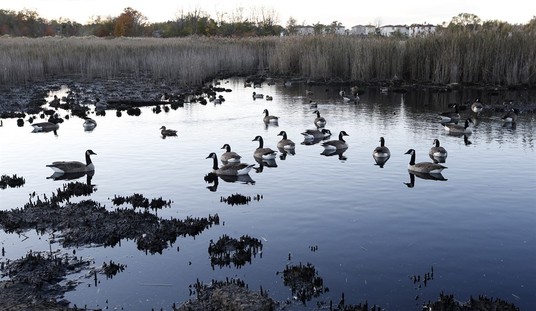The sequester happened. Nothing happened—though we all understand there will be impacts down the road. But, it didn’t have to happen.
“Sequester,” a word foreign to most of us, “is a term used to describe the practice of using mandatory spending cuts in the federal budget if the cost of running the government exceeds either an arbitrary amount or the gross revenue it brings during the fiscal year.” In short, it is what happens when the cost of running the government exceeds the revenue.
Washington only talks about two choices when the cost of running the government exceeds the revenues: raising taxes and cutting spending. Taxes were raised as a part of the fiscal cliff deal. Sequester fills out the other half of the equation by cutting spending.
But there is an overlooked option: creating new wealth—which is different from printing new money.
Creating new wealth involves producing something of value which didn’t exist before, but that someone will pay for, bringing new money into the system. Our personal budget generally works this way: we have a job that we get paid for. We use that money to pay bills and buy stuff. That same money cycles through the system and ultimately comes back to us in the form of a paycheck. And the cycle continues. But if, one day, you were digging in your backyard and you found a pot of gold—that puts new wealth into your personal system. You can sell the gold, creating new wealth for yourself.
As a country, our bills and the stuff we buy—the cost of running the government— has exceeded the revenue for some time. The same is true for many states, counties, and cities—often resulting in bankruptcy. Not every city, county, or state has a pot of gold, but in the form of natural resources—many do. Some choose to dig up the pot of gold, creating wealth resulting in a healthy community and government. Some choose not to and instead are back to the same two choices: raising taxes and cutting spending.
Recommended
On January 10, I was at a county commission hearing in New Mexico’s San Miguel County. This poor, rural county in northeastern New Mexico has geology that leads the experts to believe that there might be oil or natural gas under their feet. Several surrounding counties do have known resources and people who own the land and production companies are eager to explore to see if there is, in fact, a “pot of gold.” As is to be expected these days, there is plenty of opposition, scaring folks with talk of supposed water contamination and other calamities.
The hearing opened with a Skype presentation from the executive director of the Community Environmental Legal Defense Fund. He clearly stated that the group’s goal were to stop or block production or to create so many regulations that exploration and development was cost-prohibitive. Next a parade of naysayers, with a sprinkling of supporters, addressed the county commissioners.
The commissioners asked questions throughout the day-long process. However, they really perked up at the testimony of two county officials from the oil-producing corner of the state: Greg Niebert—County Commissioner for Chaves County; and Mike Gallagher—County Manager for Lea County. Both talked about the decades, during which fracking has been used in their counties, with only positive impacts: their schools are fully funded, unemployment is virtually nonexistent (one proclaimed that anyone who can pass a drug test can get a job), and their economies are thriving. I could almost see the dollar signs rolling through the eyes of San Miguel County Commissioners like a slot machine spinning.
Niebert produced some papers containing a resolution that the Chaves County Commission had just passed that morning. The gist of the document said that the oil and gas counties of the state were tired of supporting all the other counties—especially those that had resources, but elected not to use them. In New Mexico, revenues generated from resources extracted from state lands fill the Land Grant Permanent Fund—which is the largest contributor to the state’s schools and hospitals. Overall, the industry is responsible for nearly half of the state’s budget—which generally has a surplus. The resolution proposed that the schools and hospitals in the counties with resources that chose not to extract them should not get the benefit of the counties that do.
That is New Mexico’s story. But the theme runs through other states that are creating new wealth: Texas, North Dakota, and Pennsylvania—with a welcome increase in jobs and tax revenues. Each has very low unemployment and a thriving economy. Contrast those states to two of the states hardest hit in this time of economic demise: California and Nevada. Like New Mexico’s San Miguel Country, both have natural resources, but unlike the poor, rural county, the states’ resources are known. While San Miguel is considering a drilling ban, the troubled states have an effective ban and a big part of their pot of gold is on federally owned land. Policies and regulations could prevent the states from accessing their individual pots of gold (Nevada has the Chainman Shale and California the Monterey Shale), which would create new wealth for local communities as well as state and federal governments. David Pratt, president of Santa Maria Energy, says: “the Monterey is California’s way out of the ‘fiscal toilet.’”
California’s Senate Republican Leader, Bob Huff, agrees. He told me: “California sits on two-thirds of America's shale oil reserves, which is an economic gold mine just waiting to be safely extracted. Tapping into this reserve could cause an oil boom that would dwarf North Dakota’s oil riches that have given the state a $3.2 billion budget surplus and the nation’s lowest unemployment rate at 3.2%.”
“I am committed to new job and business creation for all Californians. We should not ignore recent technological innovations that have released a bounty of wealth in other oil-producing states and put people back to work. It makes absolutely no sense to create these new jobs and wealth in countries who are not friendly to the United States, when we can put our own citizens to work and gain energy independence at the same time.”
“But alas,” Matt Insley, a specialist on commodities and natural resources, says, “this is California. The political and environmental red tape in the state have brought energy development to a virtual halt.”
The New York Times reports: “The oil companies’ plans for the Monterey Shale are already drawing increasing scrutiny from environmental groups.” Despite the fact that “oil companies have engaged in fracking in California for decades,” Kassie Siegel, a lawyer at the Center for Biological Diversity (CBD), calls it “one of the most, if not the most, important environmental issue in California.”
Meanwhile, people are leaving the state, houses are being foreclosed, and unemployment levels are the highest in the country.
Though less-widely reported, Nevada faces a similar opportunityand opposition.
Houston-based Noble Energy Inc. has leases for 350,000 acres in ElkoCounty. They plan to spend $130 million over four years to ramp up operations. However, the Las Vegas Review Journalcites the federally owned land as “the greatest limitation Nevada faces in getting its resources to market. … Much of Noble's plan requires Washington's blessing. Midwestern states, which are composed almost entirely of private land, have no such problem, hence their prosperity.”
As we’ve seen with the Keystone pipeline, it is expected that the greens will “put on a full-court press to block the project.” Rob Mrowka, who heads the Nevada CBDoffice, says: “Fracking is not a good thing. We don't feel there is a safe way to do it.”
California and Nevada—along with New York—have known resources, yet they depend on other localesfor much of their energy. What if the states that sell their resources to California, decided to follow Chaves County’s lead and told California they are on their own? California is using the resources, but sending their money out of state—which helps the other states and hurts California.
Gabe Garcia, an assistant field officer for the Bureau of Land Management in Bakersfield, CA, reports: “the government receives 12.5 percent of revenues from the oil retrieved. … Last year we brought in $190 million.” Half of that goes to the state of California; the other half goes to the federal government. And the $190 million figure is before the Monterey Shale takes off.
Insley believes “A change in tone from the political side” could fuel a turnaround. It is the politics that is holding back a boom in new wealth creation and as California Senator Huff said: “It makes absolutely no sense.”
Sequester didn’t have to happen. Allowing, even encouraging, development of our natural resources would bring welcome new tax revenues that might even exceed the cost of running the government.
























Join the conversation as a VIP Member